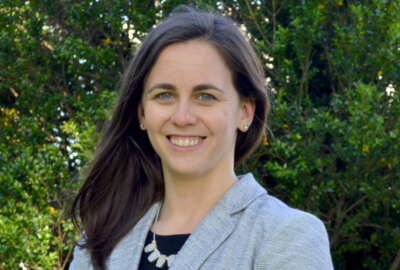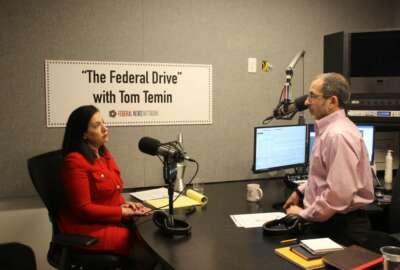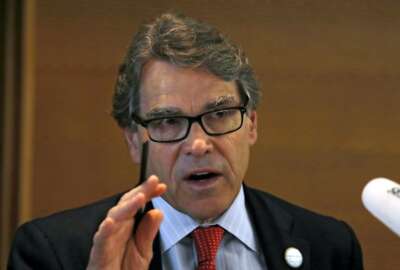
This federal scientist developed something you can’t see but will help the electrical grid
Keeping the electrical grid top notch will take more than wires. It'll take algorithms.
Best listening experience is on Chrome, Firefox or Safari. Subscribe to Federal Drive’s daily audio interviews on Apple Podcasts or PodcastOne.
Ensuring resiliency and efficiency of the electrical grid, it’s a top national security concern. Keeping the grid top notch will take more than wires. It’ll take algorithms. My next guest, a scientist at the Los Alamos National Laboratory, developed an algorithm that won the top prize in a competition, staged by the Advanced Research Project Agency – Energy. Doctor Hassan Hijazi joined the Federal Drive with Tom Temin to talk about it.
Interview transcript:
Tom Temin: Dr. Hijazi, good to have you on.
Hassan Hijazi: Thank you for having me, Tom.
Tom Temin: So you developed an algorithm, and what does it do? And how can it help the grid?
Hassan Hijazi: So the algorithm uses artificial intelligence to manage all the generators, set points or any grid in the world, basically. The competition had hundreds of different grid sizes and types and different generation types, and the algorithm had to give the optimal solution in terms of which generator to use, how much to generate, where to route the power, and all this to be able to guarantee the demand and make sure that if there’s a failure somewhere on the network, we still have the lights on.
Tom Temin: Got it. And how does the industry do that now? With a slide rule, or what?
Hassan Hijazi: No, they also use old algorithms that were developed back in the 70s or the 80s. And I think there is a gap that ARPA-E is trying to bridge there. And this is where scientists like people here at LANL can do.
Tom Temin: I’m imagining the older algorithms are a little more than collections of if then logic, such that if the voltage is here, then do that. They’re kind of simplistic.
Hassan Hijazi: They’re a bit more than that. They use what we call linear models. So electricity flows in a nonlinear fashion, but these models approximate the physics using linear models. So what we’re trying to do here is get rid of the layer models to have more accurate representation of where the electricity is going.
Tom Temin: And what has changed to enable the creation of such an algorithm nowadays?
Hassan Hijazi: Well, we have faster methods that we had in the previous years, we have methods that can take advantage of things like sparsity. Usually, when you have a mathematical model, all the variables are linked together. And if you can detect patterns in the model that can help you, you know, build faster algorithms, that’s the way to go. And this is what we exploited in our solution approach.
Tom Temin: So this sounds like an algorithm that can change its activities, depending on changing conditions and relationships that discovers AI.
Hassan Hijazi: Definitely, yes, definitely. I mean, that’s one of the advantages. The solution we had to produce had to be flexible enough to operate under different conditions with different settings, and so on.
Tom Temin: And how do you go about developing such a thing? I mean, what is the process to create a model like this?
Hassan Hijazi: Well, for me, it took 10 years, I would say, and I started working on this 10 years ago. I was an assistant professor at the Australian National University. And you know, I was interested in how the grid operates. And so I started building these more accurate, as I said, nonlinear models that can represent how electricity flows on the wires. And then, you know, one thing led to another, I was working on improving the scalability of my algorithms — make them faster, basically, make them solve bigger problems. So when you’re doing this in academia, and we’re playing with toy models, you’re solving a problem on a grid with let’s say, 100 nodes. So you have 100 generators and 100 nodes. But then when you are dealing with the real world problem, you’re suddenly looking at 30,000 nodes, if you’re thinking about the U.S. grid. And this is where, you know, you have to spend time making sure your algorithm is robust, it doesn’t diverge, it gives you a good solution every time. And so it took a lot of time, but I made it.
Tom Temin: Alright, we’re speaking with Dr. Hassan Hijazi. He’s with the Applied Mathematics and Plasma Physics Group at the Los Alamos National Laboratory. And so one of the challenges then is that, as the algorithm scales up to larger datasets, so to speak, little tiny fluctuations that might be errors at the small scale don’t translate into, golly, Niagara Falls just went dark, on the big scale?
Hassan Hijazi: Yes, correct. The bigger the networks, the more numerical instabilities you will have, especially when, you know, some lines will have very small numbers linked to them. So we talked about resistance. These are properties of the wires you have. And the bigger the network, the more variation you’ll have in those properties. So you have to take care of those.
Tom Temin: And where do you get the datasets to test on larger and larger scale?
Unknown Speaker: So that’s the nice thing that ARPA-E did. And I was really happy that they actually took the time to do it properly. They actually build the datasets from industry. So they took industrial datasets from the ISOs — the companies that are in charge of the transmission grid. And they made sure that these datas were anonymized, so people outside the industry can still look at them without having to sacrifice any security. We had hundreds of datasets to play with during the competition.
Tom Temin: Now the Energy Department sponsored the competition. You work for national lab and were the winner. Does that mean you don’t get any cash prize?
Hassan Hijazi: So the good thing is I actually participated in my individual capacity. So the prize will be given ARPA-E will be prize money that I will get.
Tom Temin: Got it. But you plan to stay with a lab, or maybe take that and commercialize this new algorithm, put in the black box and make a billion bucks?
Hassan Hijazi: No, my plan is to make it open source. I’m a strong advocate of open science. So once all is said and done, I’m gonna make it publicly available so that anyone can use it, including the ISOs in the U.S. and worldwide.
Hassan Hijazi: And what will your next project be then? Or what is it?
Hassan Hijazi: We’re working on a number of projects here at LANL. The nice thing about the lab is, you know, you get to meet people from many backgrounds. So I’m not only working on power systems, I’m also working on UAVs and cyber physical systems. So a lot of exciting projects to come.
Tom Temin: And you mentioned you were working at the, I believe, University of Australia? What is your route to end up at the Los Alamos lab?
Hassan Hijazi: Yes, I was at the Australian National University for five years, or this is when I started collaborating with scientists at Los Alamos. We were working on these power system models, and so was people here at LANL at that time. And so, they reached out to collaborate and, you know, one thing led to another and they invited me to apply here at the lab.
Tom Temin: Dr. Hassan Hijazi is with the Applied Mathematics and Plasma Physics Group at the Los Alamos National Laboratory. Thanks so much for joining me
Hassan Hijazi: Thank you, Tom, for having me.
Copyright © 2024 Federal News Network. All rights reserved. This website is not intended for users located within the European Economic Area.
Tom Temin is host of the Federal Drive and has been providing insight on federal technology and management issues for more than 30 years.
Follow @tteminWFED





